Manitoba, Canada
I have wanted to write a “top 10” grain elevator post for this site for a while. I wasn’t sure exactly what the criteria would be to choose the “top 10.” Obviously it would be subjective. I started going through the list of almost 200 grain elevators that still exist in Manitoba, eliminating the modern concrete elevators right away. I started compiling a “favorites” list but it had significantly more than 10 elevators in it!
Then I thought… Trackside Photographer . . . trackside . . . maybe I should choose the top 10 grain elevators that are still trackside! Brilliant! However, that eliminated a lot of my favorite elevators from contention. That wouldn’t do.
In the end, I chose a mix of actual trackside elevators plus a few that have not had railway tracks beside them for decades. It’s all subjective. I hope you like them.
NOTES A few notes on grain elevator architecture may be in order. The function of a grain elevator is to store grain, and to receive and dispense grain in an efficient manner. Elevators have a tall central structure which houses the elevating machinery along with numerous vertical bins to hold grain. Elevators have an attached driveway where wagons (now trucks) drive to dump their grain into a pit. A conveyor belt carries (elevates) the grain to the top of the elevator where it is directed to one or more bins. A similar process is used to dispense grain to waiting rail cars or trucks. Many elevators have one or more annexes and/or steel storage bins that were added to the sides for extra storage. Sometimes older, smaller grain elevators were re-purposed as annexes for newer, larger elevators.
Culross
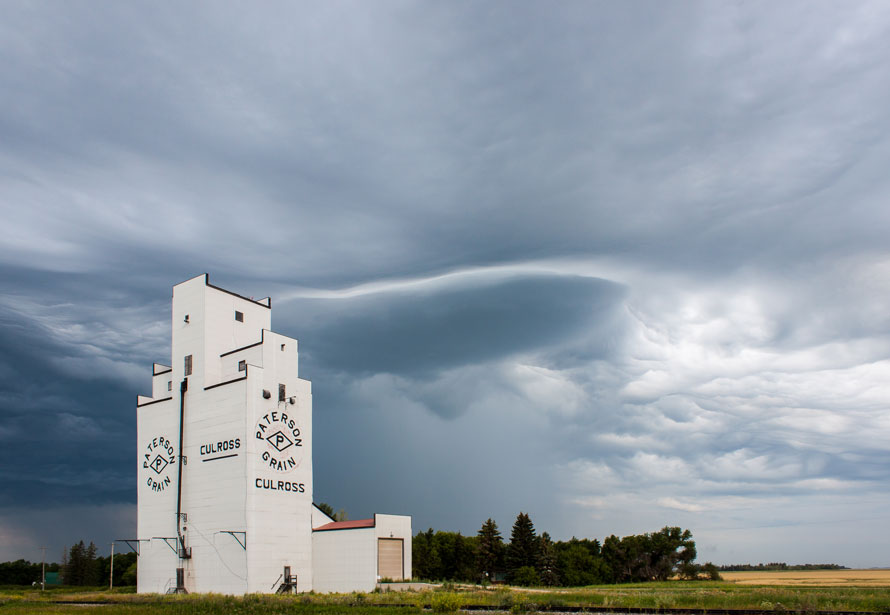
This handsome elevator is located on the Canadian Pacific (CP) Glenboro subdivision and is still in use by N.M. Paterson. I’ve always liked this elevator because it is bright white and has very clean lines. It’s unusual in that it has no annexes at all.
It is a very typical later Paterson elevator with a square cupola. The square top is a distinctive design that can be seen in Arborg, Boissevain, Holland, Kane, Pierson and La Salle. It could have been seen in Minto, Meadows and Morris but all of those elevators have been demolished since I first saw them.
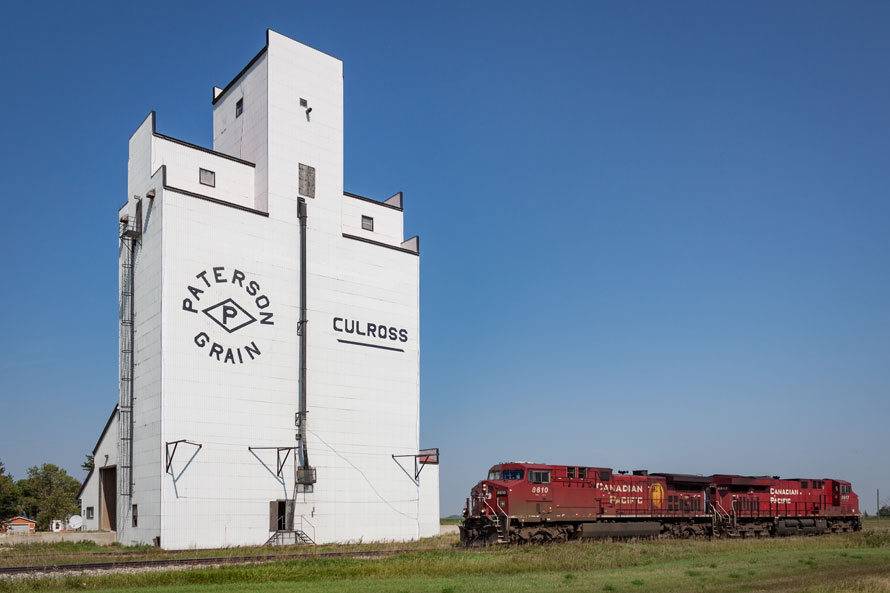
Cypress River
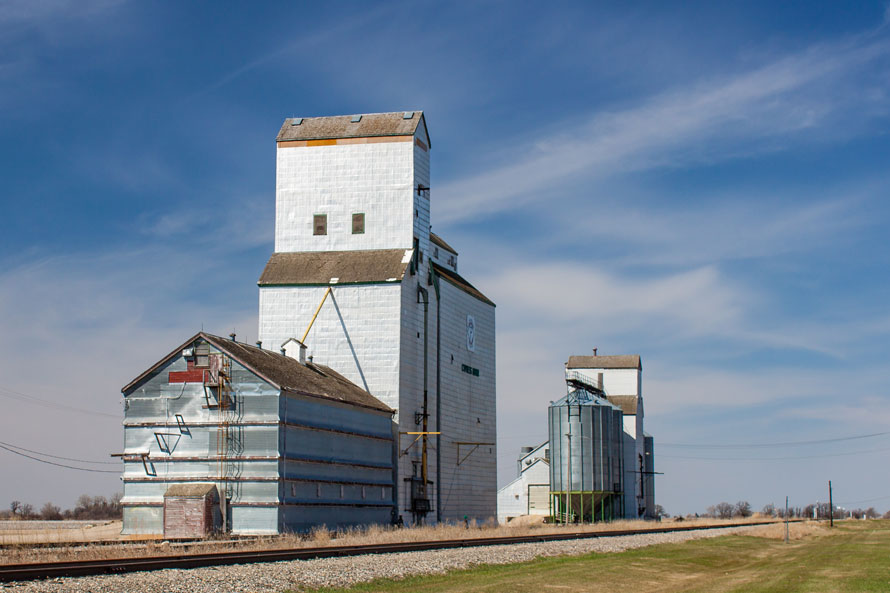
The town of Cypress River has two grain elevators. The elevator in the foreground is a former Manitoba Pool elevator, which features two different types of annexes: a horizontal annex (foreground) and a vertical crib annex (background). The elevator in the background is an ex United Grain Growers (UGG) elevator with steel bins on both sides for extra storage. Both elevators are now owned by N.M. Paterson. This town was on the CP Glenboro subdivision but no longer has rail service.
Dugald
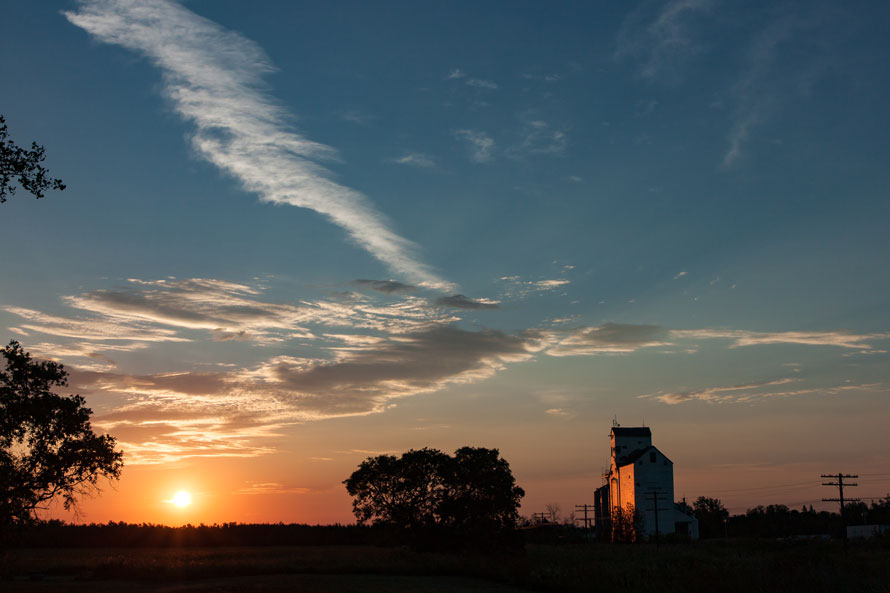
The former Manitoba Pool elevator in Dugald is a very typical Pool design. It has a large wooden annex on one side and three large steel bins on the other. It is still in use for grain storage, but I do not believe it gets rail service despite being on the busy Canadian National (CN) Redditt subdivision just east of Winnipeg. It is a favorite of mine because it is one of the closest wooden elevators to me and provides a great background for train photography.
Dugald is probably best known for being the scene of a serious railway collision on September 1, 1947, where passenger train CN Extra 6001 (the “Minaki Campers’ Special”) collided with the eastbound Continental Limited train. The engineer and fireman of the extra train died in the collision, but the other 29 fatalities were due to fires on the older gas-lit cars on the extra train.
Elva
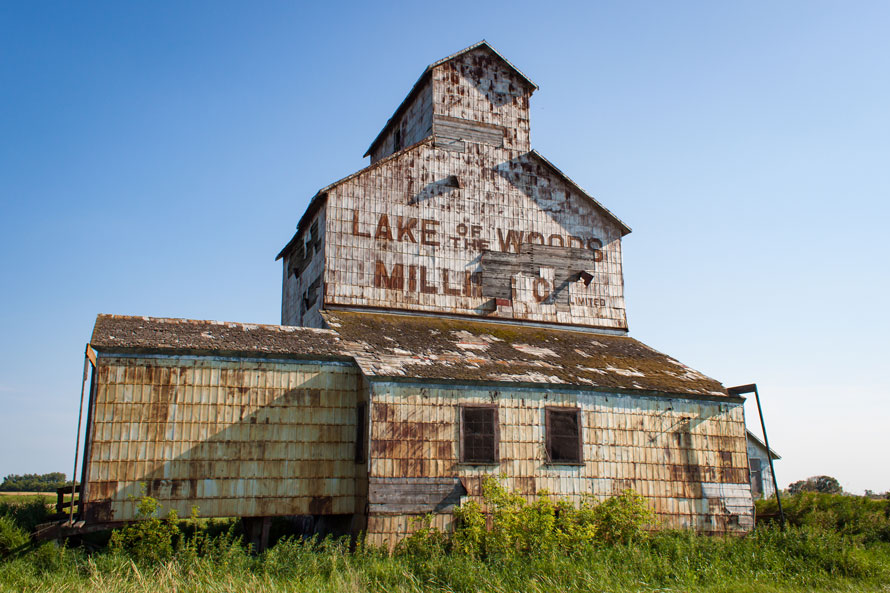
The tiny town of Elva has the distinction of hosting the oldest remaining grain elevator in the Prairies. That distinction used to belong to the elevator in Fleming, which is just over the Saskatchewan border along the Trans-Canada Highway, but after that was destroyed by arson the honor fell to Elva. No one is quite sure when this Lake of the Woods elevator was built, but the consensus is that it was built on or about 1897. It received a new foundation in 1950 but the elevator itself appears to be unchanged from its first construction. Certainly its squat shape is unlike other, more modern, grain elevators. This elevator was retired by the Manitoba Pool in the 1960s and has been dormant for years.
Next to the Lake of the Woods elevator stands a UGG elevator in poor condition. It was built around 1916. One clue to its age is the large UNITED GRAIN GROWERS on the side, rather than the blue “UGG” symbol used later.
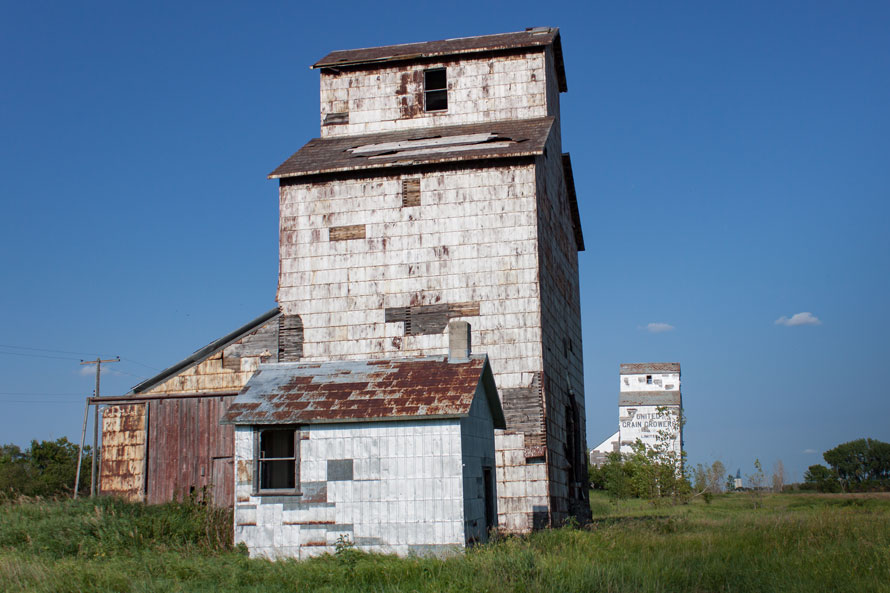
These two elevators are adjacent to the CP Estevan subdivision but have not had rail service in decades.
There is a working grain elevator outside the town itself. The third Elva grain elevator is a concrete structure built in 2000 by Agricore, the successor to the Manitoba Pool. It was sold to Cargill in 2007 and was later expanded in 2014 to its present capacity of 24,500 tons. It has its own locomotive to switch grain cars.
Justice
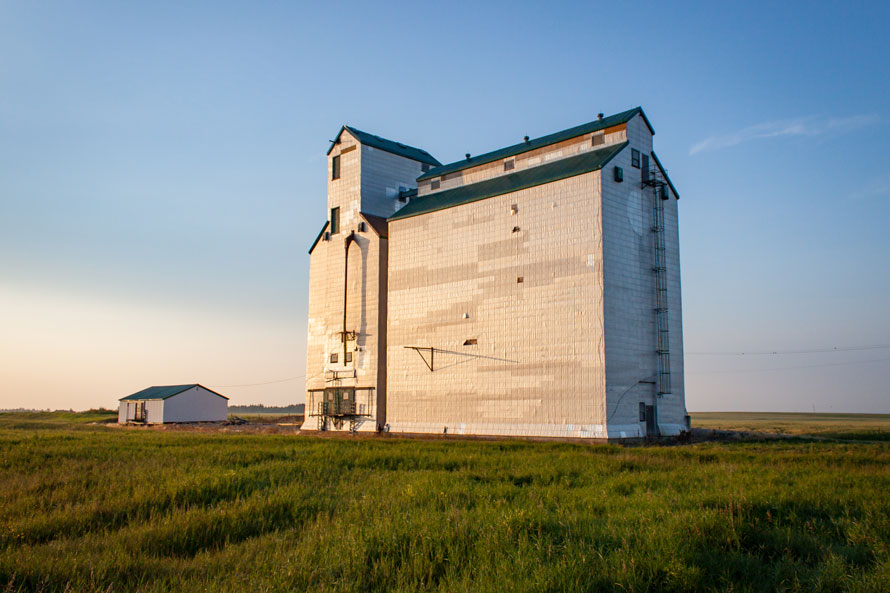
The elevator in the tiny town of Justice is another typical Manitoba Pool elevator. It has a large wooden annex on one side. There is a foundation on the opposite side which probably held another annex or steel bins. The site does retain a detached building that would have been used for storage of fertilizer and other flammable products that had to be kept separate from the wooden elevator.
The busy CN Rivers subdivision is adjacent to the elevator. This was originally built by the Grand Trunk Pacific Railway, which used an alphabetical system for naming its stations in the west. Justice was the “J” after Ingelow and before Knox.
Killarney
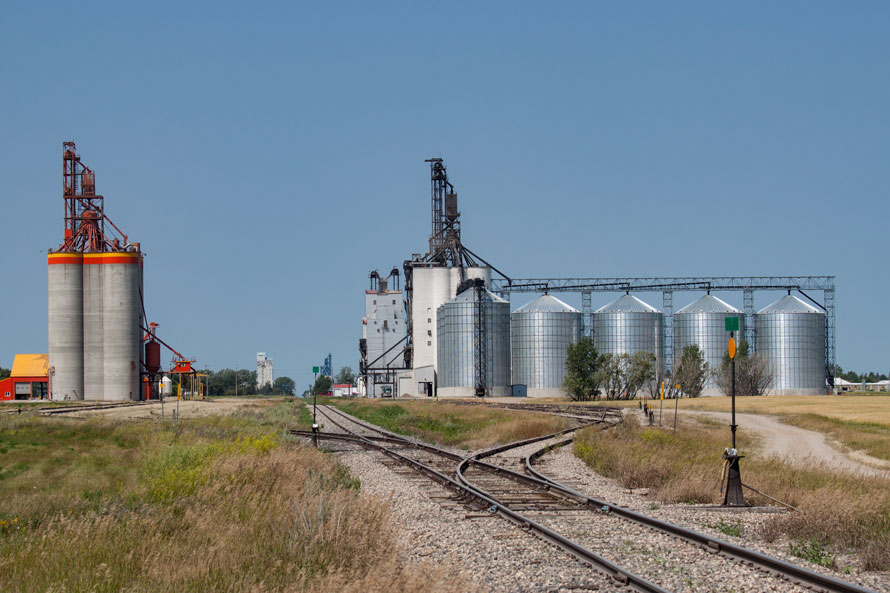
There are five grain elevators in Killarney, but at the time of publication there might be one less.
There are two modern concrete grain elevators in Killarney – one owned by N.M. Paterson and one by Tri Lake Agri, a subsidiary of Richardson Pioneer.
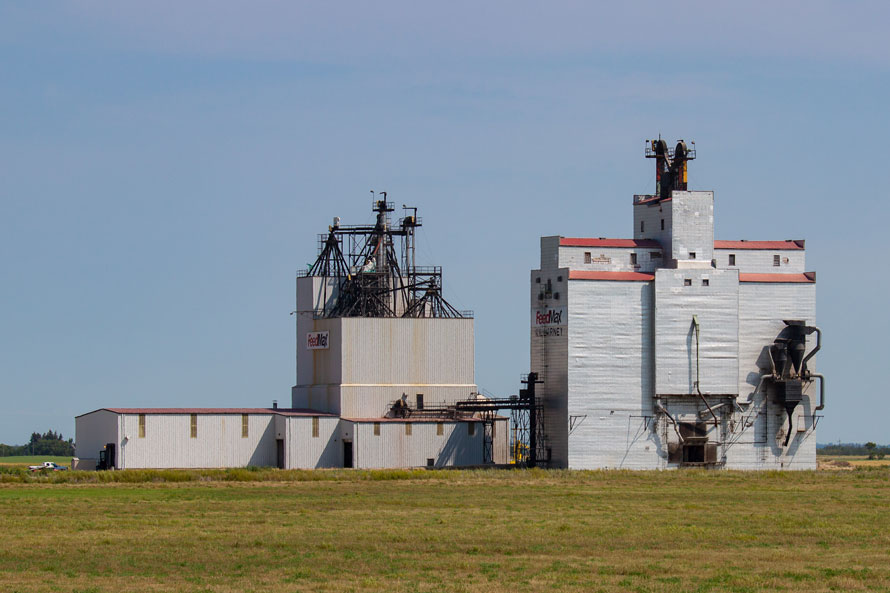
A third elevator is part of the FeedMax complex, owned by Paterson GlobalFoods. It is not clear if this was originally a grain elevator converted for feed use, or if it was purpose built for feed use. Compare the central portion of the structure with the Culross grain elevator to see the Paterson heritage.
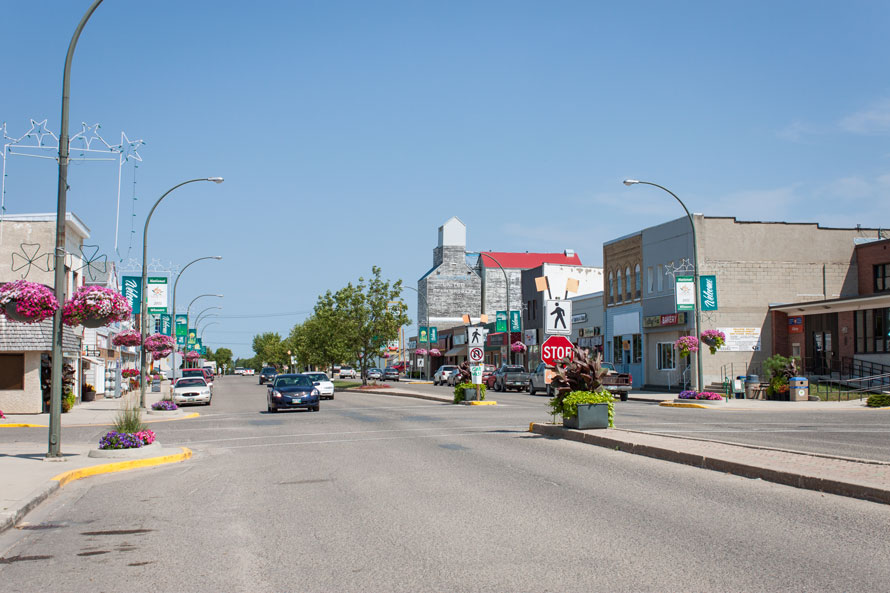
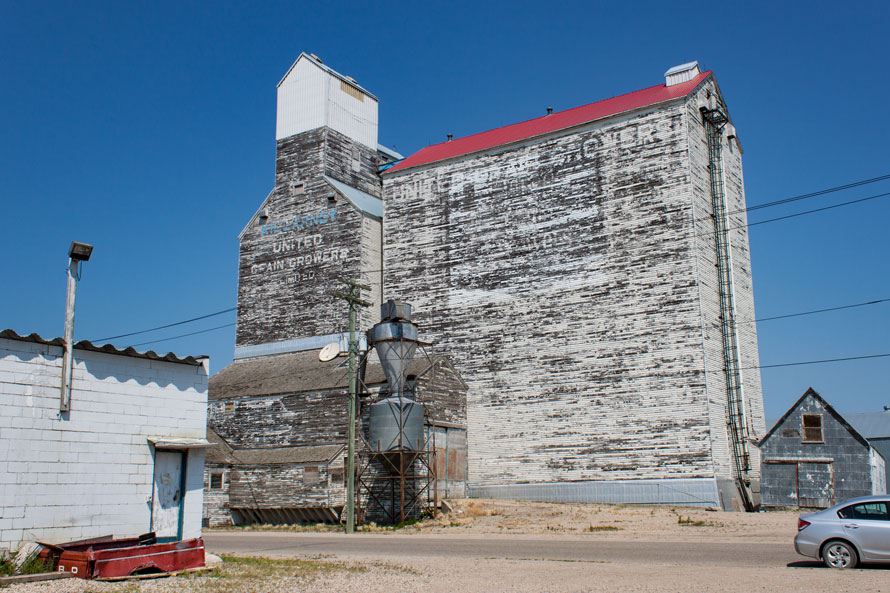
The fourth elevator in town is an ex UGG grain elevator, located downtown. This elevator, built in 1953, is in the process of being demolished and will be gone by early October at the latest. At one time it was part of the “elevator row” common in many Prairie towns, with this elevator (plus annex), a smaller UGG elevator, and two Manitoba Pool elevators all in a line along the south side of the railway tracks. (http://www.mhs.mb.ca/docs/sites/killarneyelevator.shtml)
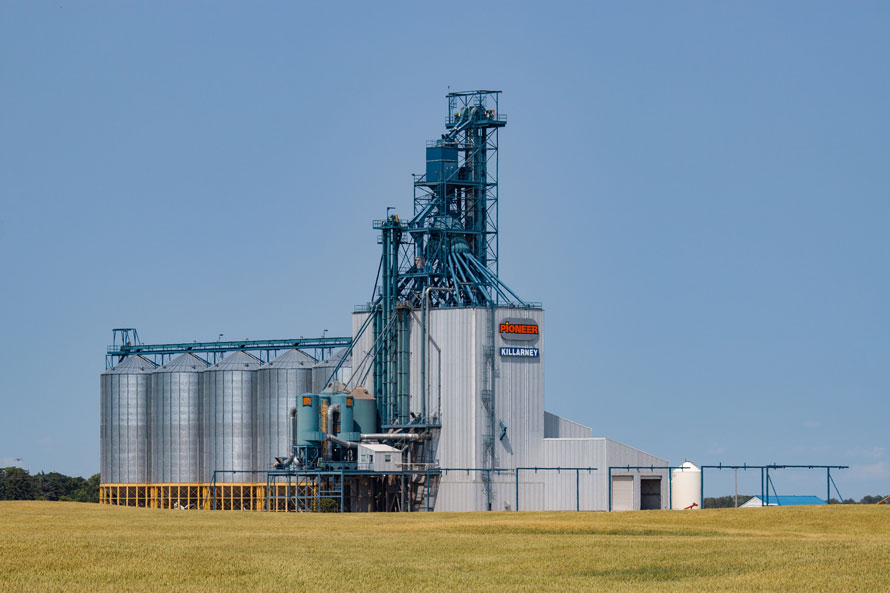
The fifth Killarney grain elevator is located just outside the town. It is a steel elevator, built by the Manitoba Pool and now owned by Richardson Pioneer. Steel grain elevators are relatively rare, with Binscarth and Somerset containing the only other examples in Manitoba. Steel grain elevators proved more expensive to build than wooden grain elevators, and they were superseded by concrete elevators in a short period of time.
Killarney is at the end of the CP Napinka subdivision, which used to stretch to La Riviere where it met the La Riviere subdivision.
Napinka
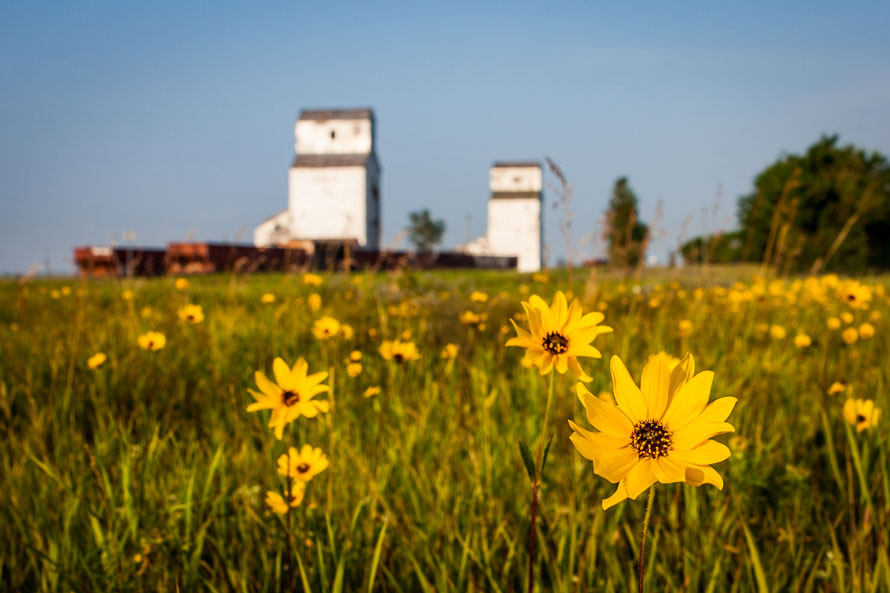
There are two grain elevators in Napinka. Both were Manitoba Pool elevators before retirement, but one clearly shows its Ogilvie Flour origins now. The Ogilvie elevator was taken over by the Pool in 1959 and became the “B” elevator in town. There are several former Ogilvie elevators in Manitoba.
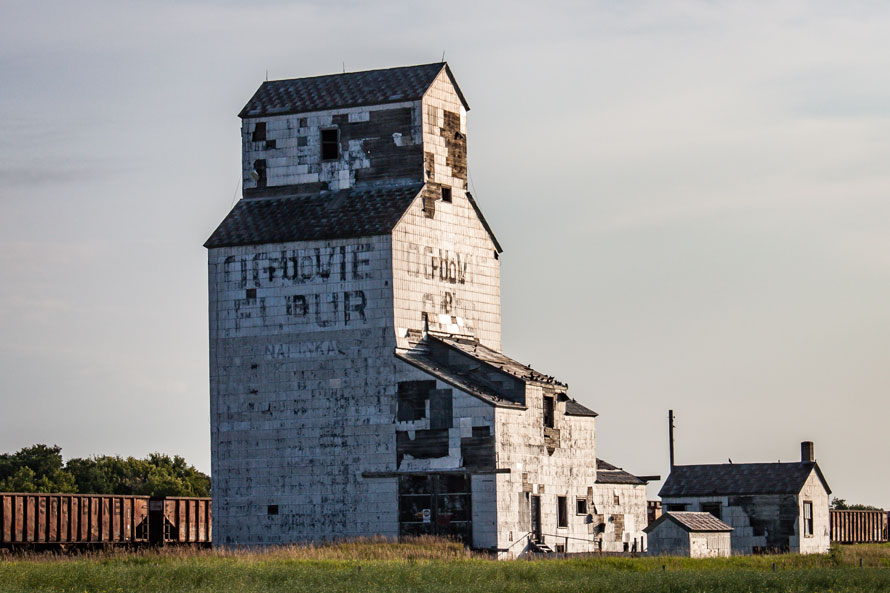
The town is on the CP Estevan subdivision, which stretches well into Saskatchewan, and is also the start of the CP Napinka subdivision, which goes south and east to serve several grain elevator towns before terminating just east of Killarney.
Newdale
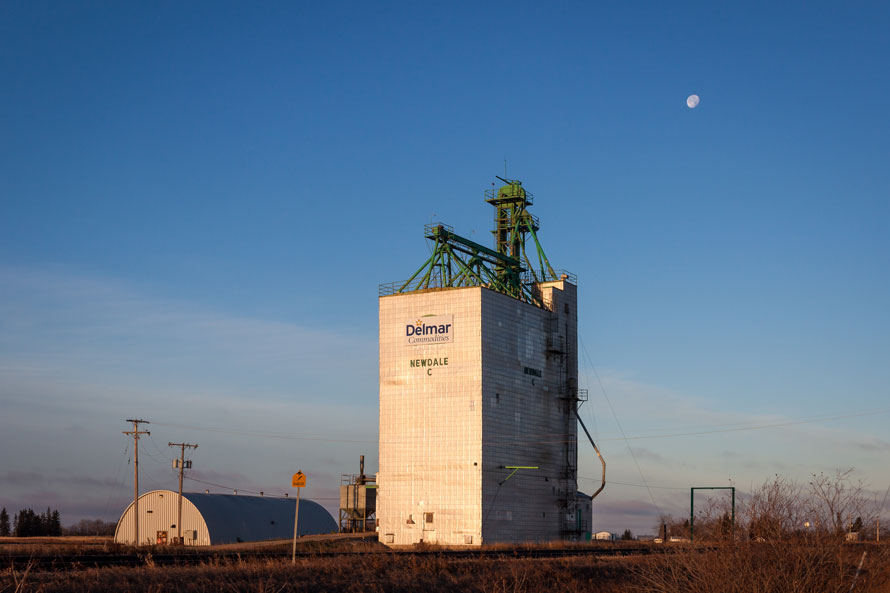
There are two grain elevators in the small town of Newdale . . . or three, depending on how you want to count them.
This square elevator was built by the American company Cargill in 1980 with a capacity of 3,920 tons. It is a good example of one of the last types of wooden grain elevators built, with the elevating machinery in the open on the roof and sides of a square building. Other existing elevators of a similar style can be seen in Elie, Niverville, Shoal Lake, Solsgirth, and Westroc. The elevator was traded to Manitoba Pool in 1995, becoming their “C” elevator, and went into private hands before being purchased by Delmar Commodities, who operate it today.
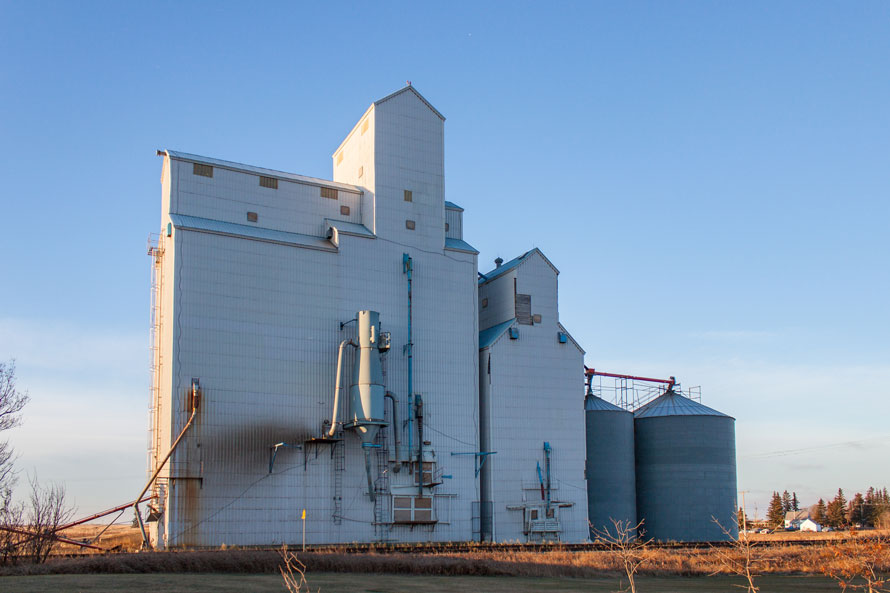
The other Newdale grain elevator is an ex United Grain Growers (UGG) elevator . . . or elevators. The complex consists of a larger elevator, a smaller (older) elevator, and two steel bins. The smaller elevator was built in 1925. As with many elevators, modifications were done over the years and the smaller elevator received two annexes, which were later demolished. The foundation for the smaller elevator is cracked and it is no longer in use, and is leaning toward the larger elevator.
The larger elevator was built by UGG in 1983, and is one of the last wooden grain elevators built in Manitoba. There are two others like it in Manitoba, at Norman and Mariapolis.
These elevators are served by the CP Bredenbury subdivision.
Oberon
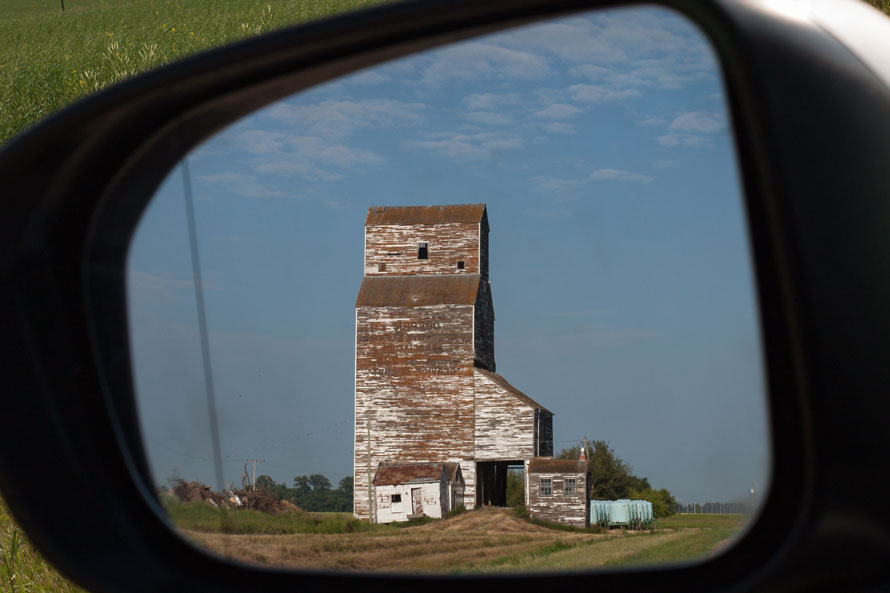
My favourite grain elevator in Manitoba is in Oberon, south of Neepawa on highway 353. This grand old wooden elevator was built around 1903 by the Ogilvie Milling Company, later acquired by the Manitoba Pool. The elevator was rebuilt in 1959 but lost rail service in 1978 when the CP Varcoe subdivision was closed. It was acquired by a local farmer, and the land is still used for storing equipment although it is not clear whether the elevator is still used for grain storage.
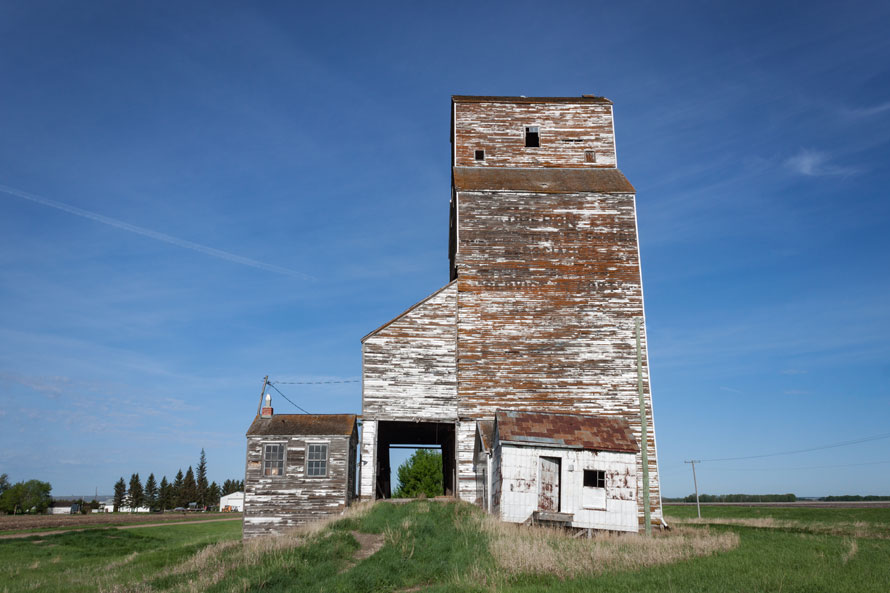
The Oberon elevator still shows the standard Manitoba Pool wording on the side: OBERON CO-OPERATIVE ELEVATOR ASSOCIATION. POOL No. 123. “SERVICE AT COST” Most wooden grain elevator were later sheathed with tin for fire prevention and a large green Manitoba Pool roundel and green town lettering was applied to identify the elevator. That green lettering can be seen on the Snowflake and Newdale elevators in this article.
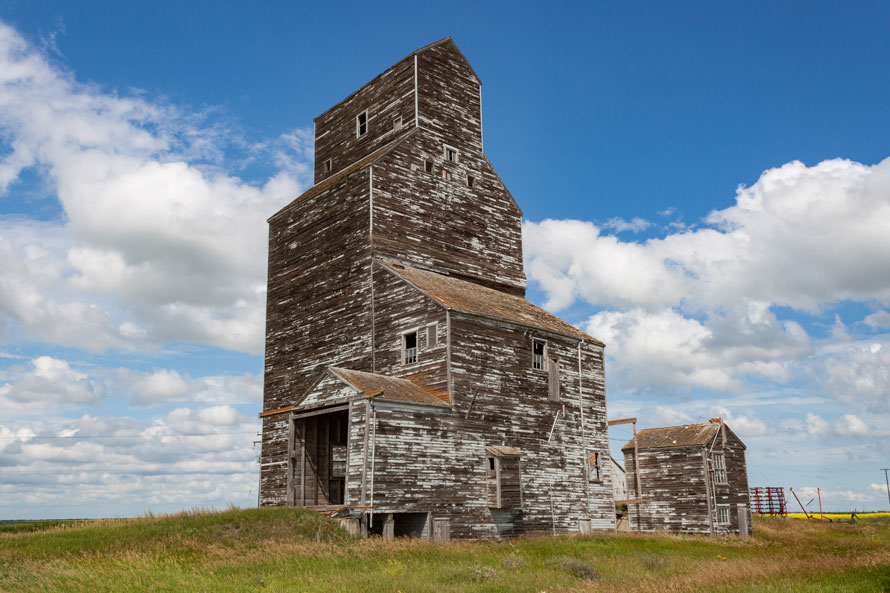
The elevator has a detached office, common for early grain elevators when they still used gasoline-powered motors to operate the legs. Later elevators used electric motors which were fire-safe and the office was usually incorporated into the driveway.
Snowflake

The town of Snowflake, located close to the US border, is a beautiful example of a Prairie town in its last stages. Few people still live in the town and its main street (Railway Avenue, a typical Prairie street name) is populated with closed businesses, overgrown sidewalks and vacant houses. On the other side of the main street stand two grain elevators on the former right-of-way: a former Federal grain elevator and a former Manitoba Pool elevator.
The town sat on the CP Snowflake subdivision, which was a tenuous branch line at best. Canadian Pacific abandoned the line in 1977, and the town went into a slow decline, with the school closing in 1992 and the church closing in 1994.
Today the town is quiet, with the two elevators standing idle, surrounded by fields of canola and wheat and not a lot of people.

FOR MORE INFORMATION If you are in Manitoba, you can visit the excellent Inglis Grain Elevators National Historic Site which features the only intact elevator row (5 elevators) in Canada. The former Manitoba Pool grain elevator in Plum Coulee has been converted into a museum and can be toured. Online you can visit my Manitoba Grain Elevators site or the Manitoba Historical Society's This Old Elevator project for more information on specific Manitoba grain elevators.
Steve Boyko – Photographs and text Copyright 2017
See more of Steve’s work at Confessions of a Train Geek and on Facebook and Instagram
This is a wonderful report with beautiful photography. The first shot with the storm clouds is stunning.
Thank you, Dennis! I was just starting out on a grain elevator excursion when I encountered that storm by the Culross grain elevator. I loved the look of it but I was afraid that the storm was going to ruin the rest of my day with rain and cloud… fortunately it was a very small storm and within half an hour I was back into sunshine for the rest of the day!
Great review of a part of our culture that few people today even know exists. Great use of unusual angles for the photographs, such as the auto side mirror. It’s wonderful to see these “taken for granted” structures presented in such an interesting way. Thank you!
You’re welcome, Bob! Thank you for your kind comments.
Beautiful series…that Dugald shot is special.
Thank you, Kevin, it was a lovely night for photography at Dugald.
Love the photos!
It says the elevator in Cypress River with the steel bins was an ex UGG elevator……..no it never was UGG, it was Paterson right from when it was built around 1926. Paterson took over the ex Pool elevator in 2004 and they are both in use to this day (April 2022)
That’s a fantastic factual post which must have taken much research and assembling. The photos are great and this is ‘Mission Accompli’ I also enjoy your posts on Cdn Trains.